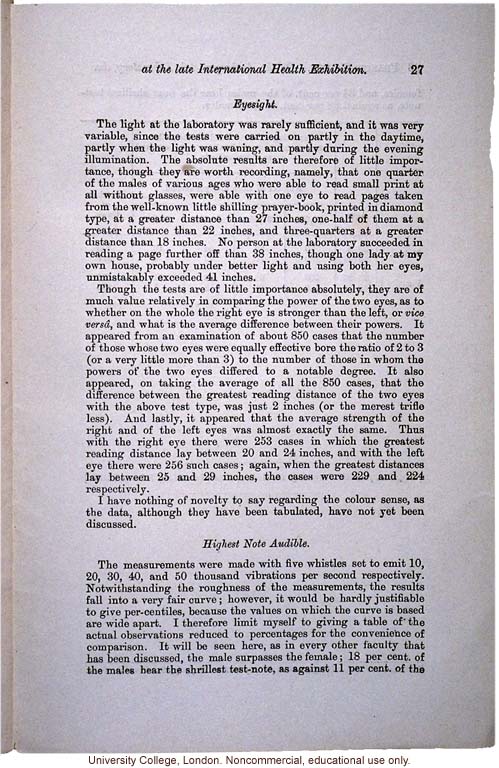at the late International Health Exhibition. 27
Eyesight.
The light at the laboratory was rarely sufficient, and it was very variable, since the tests were carried on partly in the daytime, partly when the light was waning, and partly during the evening illumination. The absolute results are therefore of little importance, though they are worth recording, namely, that one quarter of the males of various ages who were able to read small print at all without glasses, were able to shut one eye to read pages taken from the well-known little shilling prayer-book, printed in diamond type, at a distance greater than 27 inches, one-half of them at a greater distance than 22 inches, and three-quarters at a greater distance than 18 inches. No person at the laboratory succeeded in reading a page further off than 38 inches, though one lady at my own house, probably under better light and using both her eyes, unmistakably exceeded 41 inches.
Though the tests are of little importance absolutely, they are of much value relatively in comparing the power of the two eyes, as to whether on the whole the right eye is stronger than the left, or [italics]vice vers[circumflex over 'a'][end italics], and what is the average difference between their powers. It appeared from an examination of about 850 cases that the number of those whose two eyes were equally effective bore the ratio of 2 to 3 (or a very little more than 3) to the number of those in whom the powers of the two eyes differed to a notable degree. IT also appeared, on taking the average of all the 850 cases, that the difference between the greatest reading distance of the two eyes with the above test type, was just 2 inches (or the merest trifle less). And lastly, it appeared that the average strength of the right and of the left eyes was almost exactly the same. Thus with the right eye there were 253 cases in which the greatest reading distance lay between 20 and 24 inches, and with the left eye there were 256 such cases; again, when the greatest distances lay between 25 and 29 inches, the cases were 229 and 224 respectively.
I have nothing of novelty to say regarding the colour sense, as the data, although they have been tabulated, have not yet been discussed.
Highest Note Audible.
The measurements were made with five whistles set to emit 10, 20, 30, 40, and 50 thousand vibrations per second respectively. Notwithstanding the roughness of the measurements, the results fell into a very fair curve, however it would be hardly justifiable to give per-centiles, because the values on which the curve is based are wide apart. I therefore limit myself to giving a table of the actual observations reduced to percentages for the convenience of comparison. It will be seen here, as in every other faculty that has been discussed, the male surpasses the female; 18 per cent. of the males hear the shrillest test-note, as against 11 per cent. of the
[end]


